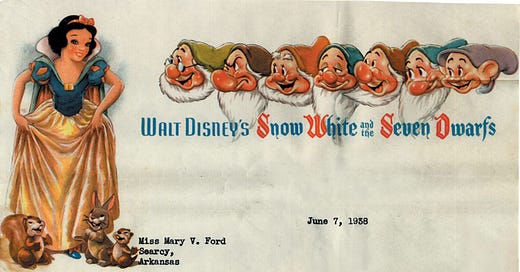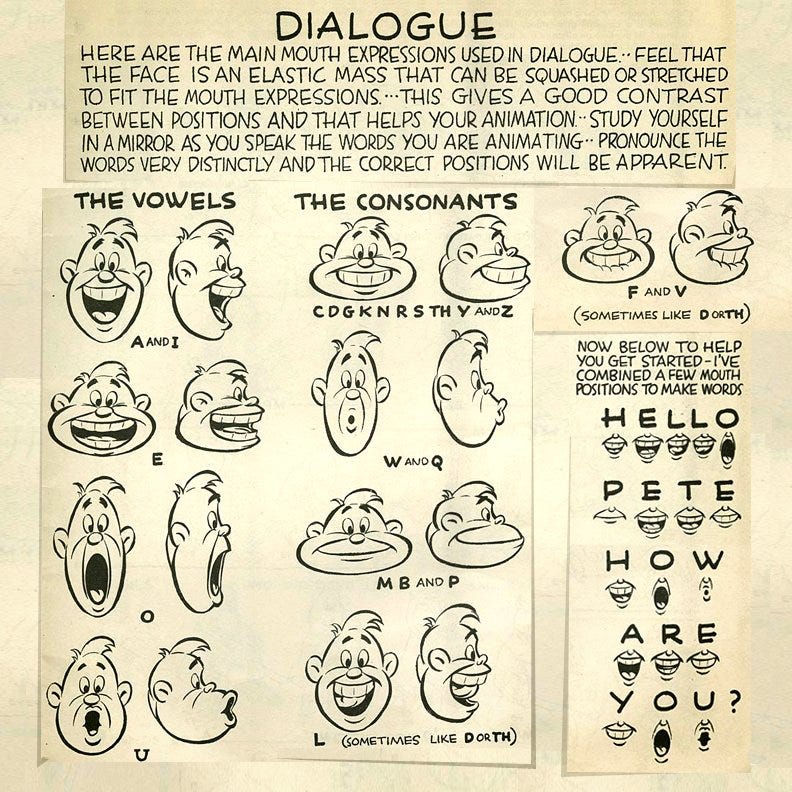Selby Kelly and Women in Animation
There were no historic Queens of Animation. There were mostly Cinderellas.
There is a modern idea that Women had the same opportunities as men in the early days of animation. Some women were hired and credited as animators, but they were exceptions. You can count them on the fingers of one hand. Often, they were assisting and not getting credited for their animation. Women were not in the Disney training program because, as the infamous 1938 Disney ‘form’ rejection letter to female applicants stated, all of the creative work ‘is done by young men’.
This makes no sense since no one ever sees the animators on screen—and inkers and painters were highly trained artists. And it was THEIR work that appeared on the screen.
Animation is actually more sexist than live action because female characters in live action are usually performed by actresses. Animated heroines, on the other hand, were ‘traditionally’ animated by men at the Disney studio. Only one human male character was ever led by a female animator at that studio before the digital age (Kathy Zielinski was supervising animator on Judge Frollo in THE HUNCHBACK OF NOTRE DAME.)
I think things are better now since there are now many more Women in Animation. But I encountered a LOT of discrimination because of my age (too young and/or too old), my sex, my background, and my appearance (women were expected to be ‘decorative’). I was hired as an animator before I graduated from Cal Arts, which I did not expect. Even then, Jack Zander paid me very little at first and when I asked for a raise after finding out that I was making less money than assistant animators, he said, “You’re making a lot of money for a girl!” I replied, “I’m not making a lot of money for an animator, Jack, and if you hire me as a girl, I charge you DOUBLE!” (He gave me the raise.)
Some of the male animators in new York, notably Doug Crane, Tony Eastman, and Dean Yeagle, were great, professional colleagues with immense talent who treated me as an equal. Some of the other male animators in New York and, sadly some other places, objected to my existence. They hated all women who had the presumption to be animators. My opinion of their work was as low as their opinion of me.
A freelance male assistant at Zanders called me one day and loudly stated that my lipsynch was ‘totally wrong’. I replied that I couldn’t see the problems on the phone, and asked him to bring me the scene. He came into my office to ‘point out’ how I wasn’t doing mouth action the way Preston Blair drew it in his book.
I looked at him in disbelief. The animated character was two inches high, had a long beard, and one tooth. His mouth was a hole in the beard. Preston Blair used exaggerated mouths, never intended them to be standard, and told me this personally. (Yes, I worked with Preston Blair. I’m old). “This had better be a joke,” I said through my teeth. Then checked every drawing while he stood there, sweating, to make sure he hadn’t changed a single mouth. Then told him to leave my office. And I requested that someone else assist my scenes from then on.
One day the production manager told me that another assistant animator wanted to speak with me. And that is how I met Selby Kelly. She’s known to most of you as the widow of Walt Kelly, but she had a long, long career in animation before she met him. Selby was head paint mixer on SNOW WHITE, PINOCCHIO, FANTASIA and BAMBI. She left during the strike and went to Warner Brothers. She was President of an animation union and ran her own studio, directing films with her first husband Roger Daley. She married Walt Kelly a few years after they met at the Chuck Jones studio during production of the Pogo Special Birthday Special in 1968.
Selby wasn’t there to complain. She’d replaced that idiot first assistant, and wanted to know who this ‘ new girl animator’ was. She liked my animation. And she told me that she had applied, in 1936, in person at Disneys at the Animation building and was told ‘go across the street to Ink and Paint. We don’t hire women.’
“ We were told that women can’t animate,” Selby said. “Why?” I asked. “Because we just can’t!” She was still hurt and angry about this all those years later.
We became friends and I asked her about her time at Disney’s. “Did you meet Walt Kelly there?”
“He would look out of the window of the Animation Building as I was walking to Ink and Paint, and watch me every day. But that was as far as it went. We did not meet until many years later.”
“You never met in the cafeteria?”
“I could not afford to eat there on my fifteen dollar a week salary. Ink and Paint had a sandwich cart.”
“What about at the studio?”
“If an inker or painter walked into the Animation building for any reason, she was fired.”
In 1981 Selby asked me to lecture with her at the Philadelphia Museum of Art about the making of SNOW WHITE AND THE SEVEN DWARFS.
“I wasn’t even thought of in 1938. My parents were children.”
“YOU met the animators. You know them.”
“You never met them at studio parties?”
“WITHOUT A PROPER INTRODUCTION?”
We lectured to about a thousand people. I was terrified. But it went well. And the tape has survived. I will upload it in a later post. I never said that I was going to be chronological. The thing that impresses me most is that Selby was constantly upstaged by the male interviewer. Since she was a lady, she did not object. She had a beautiful voice. She uses it politely.
Selby behaved very differently when we presented a lecture on Women in Animation at the Museum of Cartoon Art that same year. She was completely in control. She talked like a director, because she was one. She deferred to no one, and ran the session masterfully. And it was such a popular talk, we gave it twice.
I spoke, along with assistant animator Helen Komar and layout artist Linda Daurio. I was introduced as the one who went to school, and ‘didn’t come up the hard way’. I was just beginning to learn how hard it was.
Helen Komar was in the second generation of female animators. She had it no better than Selby. At 25:00 she says, “In the Fifties, ‘inbetweener’ was as far as a woman could go” There was no opportunity for promotion at Famous Studios and she gives the ‘reason’. And you literally heard it here first. CLICK HERE FOR THE AUDIO.
This lecture is appearing online for the first time. It is slightly edited, since Helen sounded clearer in the first lecture, and I did better in the second. I’ve edited Helen’s remarks in and Linda’s out (sadly, she is inaudible on the tape.)
You’re welcome.






I always enjoy anything you choose to post, but I am particularly delighted to hear of your friendship with Selby Kelly. I have all the books she put together about Walt and POGO, but she doesn't talk about her own career very much. The famous rejection letter to an aspiring woman animator is maddening.
Great post! Very interesting history. I knew about the 'only ink and paint' work available to women since reading about it in the first Disney animation book that I found - Bob Thomas's first edition of his Disney's Art of Animation. But in that book, from the late fifties, it was considered natural, and indicated that women were much better at ink and paint because they had a more delicate touch. I have to say that when we worked together at Jack's I never thought to consider your animation - of rampaging bulls and roaring motorcycles - as being particularly 'delicate'! Unless, of course, it was supposed to be.